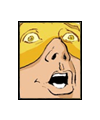
Showing posts 16 - 20 of 53 matching: hunter
Saturday, September 11, 2021
Looking Back
Justice League America #56 was released on September 17, 1991, thirty years ago next week. Its mawkish story takes place in the middle of the too-long "Breakdowns" event marking the denouement of the United Nations-sponsored Justice League International era.
This chapter focuses on the forsaken Leaguers struggling to adapt to life without a league. Among them, Fire and Ice struggle to join a modeling agency, and Blue Beetle finds that his poor physical health will prevent him from joining the Booster Gold-led Conglomerate. There aren't a lot of "bwah-ha-ha" moments here.
No matter how you look at it, "Breakdowns" was not a particularly good story, and this wasn't a particularly good issue. As much as we want them to be, not all comics can be masterpieces.
But this comic book is worth a look back today if for no other reason than for its cover by Chris Sprouse and Bruce D. Patterson. As pretty as it was at the time, it was made more poignant by events that transpired almost exactly ten years after the issue's publication.
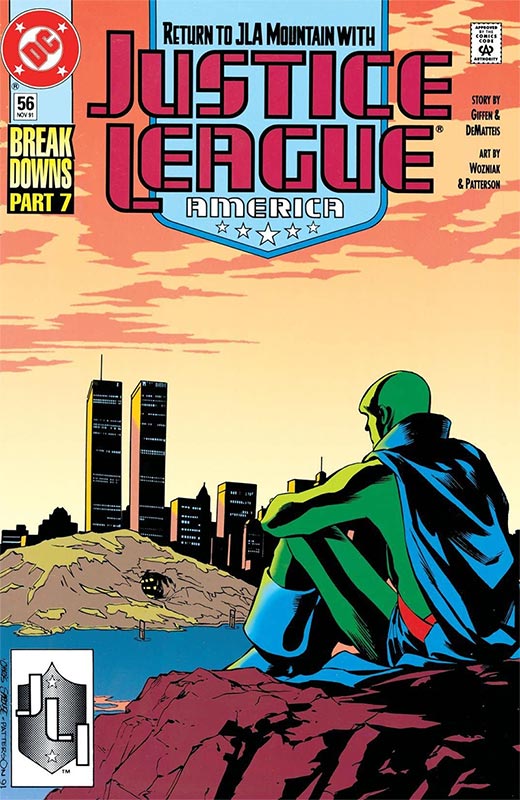
#NeverForget
Comments (0) | Add a Comment | Tags: 911 bruce d. patterson chris sprouse justice league international martian manhunter world trade center
Wednesday, July 14, 2021
We Need to Talk about Flash
This name drop is the closest that Booster Gold comes to making an appearance in this week's The Flash 2021 Annual:
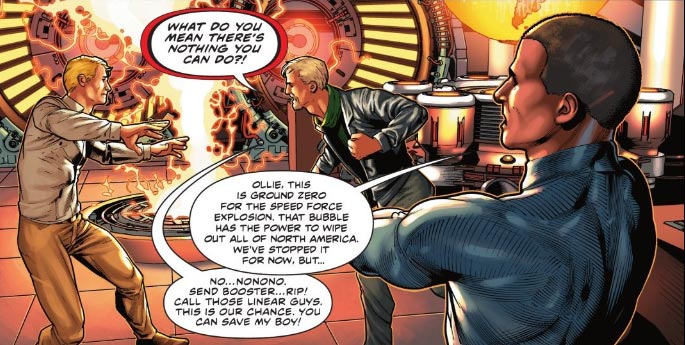
words by Jeremy Adams, art by Fernando Pasarin, Brandon Peterson, Hi Fi, Michael Atiyeh, Steve Wands
For what it's worth, it's cool that Booster and Rip Hunter are still Time Masters in the DCU. Though how Green Arrow knows Booster is a time cop isn't clear. Do secret identities mean *nothing* in modern comic books? And if everyone knows that Booster Gold is a time cop, why hasn't anyone called him in to help while Wally West has been bouncing through time for the past few months? Maybe it's best if I don't climb down this rabbit hole....
Still, I have to admit that I had expected more in an issue revisiting the events detailed in Heroes in Crisis. Especially since a key element of that story was Wally framing Booster Gold for murder.
The DC Universe has been rebooted (twice!) since Heroes in Crisis. It would be so easy to say that the murders at Sanctuary didn't happen. I won't spoil any of the details of the issue, but The Flash 2021 Annual doesn't want to ignore all of that past, just the parts that are inconvenient. Inconvenient to Wally West, I mean.
Gunfire and Lagoon Boy might be alive again somewhere in the Multiverse. (Thanks, Infinite Frontier!) And Professor Zoom has taken credit as the true puppet master behind Wally West's criminal acts. (Thanks, Flash Forward!) Apparently now we need another excuse for why none of whatever happened was really Wally's fault in the first place. (Thanks, The Flash 2020 Annual!) Funny how one bad story can generate a cottage industry of retcons. (Thanks, Tom King!)
Anyway, Booster has forgiven Wally, and The Flash 2021 Annual wants us all to follow suit. So I'll try to forgive it its flaws. Any book that finally gets rid of Wally's over-detailed New 52 costume can't be all bad.
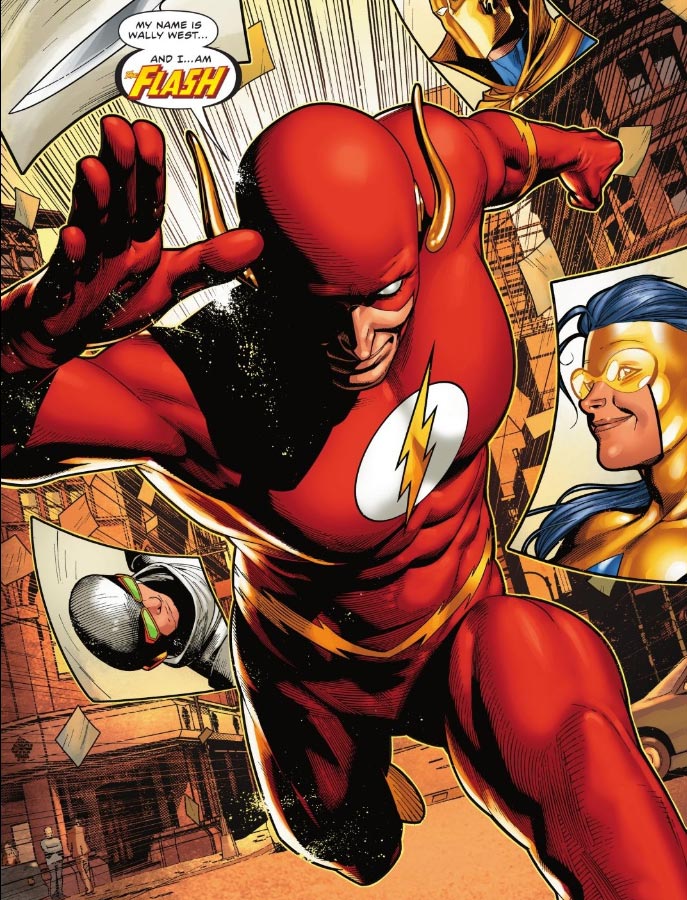
Is this the last appearance of the Gold Beetle? Only time will tell.
Comments (1) | Add a Comment | Tags: flash gold beetle green arrow heroes in crisis rip hunter
Wednesday, June 16, 2021
This Day in History: Black and Gold
DC chose not to release any comic featuring Booster Gold appearances this week. I like to think that's because they'd rather you spend some time re-reading classic Booster Gold adventures.
May I suggest Justice League Annual #1, released 34 years ago today?
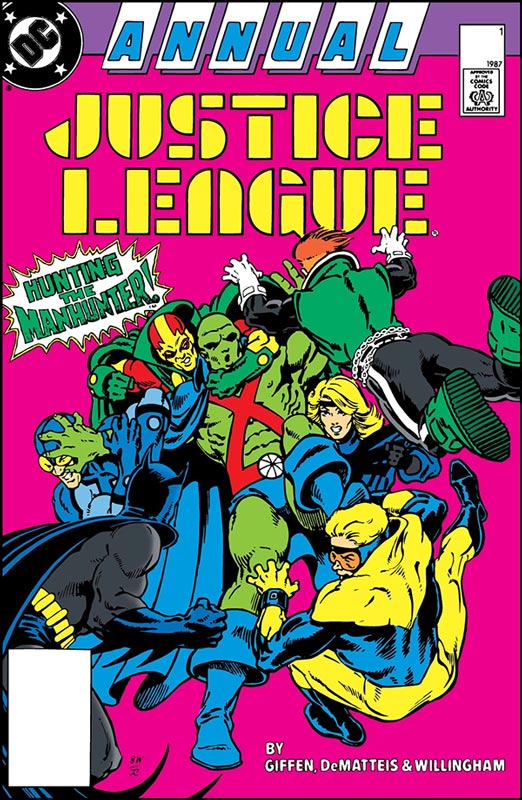
This 48-page issue, essentially a zombie story titled "Germ Warfare," is Booster's first adventure as an accepted member of the Justice League. (And you don't have to take my word for it. The editor's note on page 4 explicitly places the story immediately after Booster's JL audition in Justice League #4 (which also happens to be the single best Booster Gold story ever).
The action unfolds in the traditional Justice League style. To combat a global menace, the team splits in to pairs. Interestingly, Booster Gold's first Justice League partner isn't Blue Beetle but another legacy character with origins in the Golden Age of comics: Black Canary.
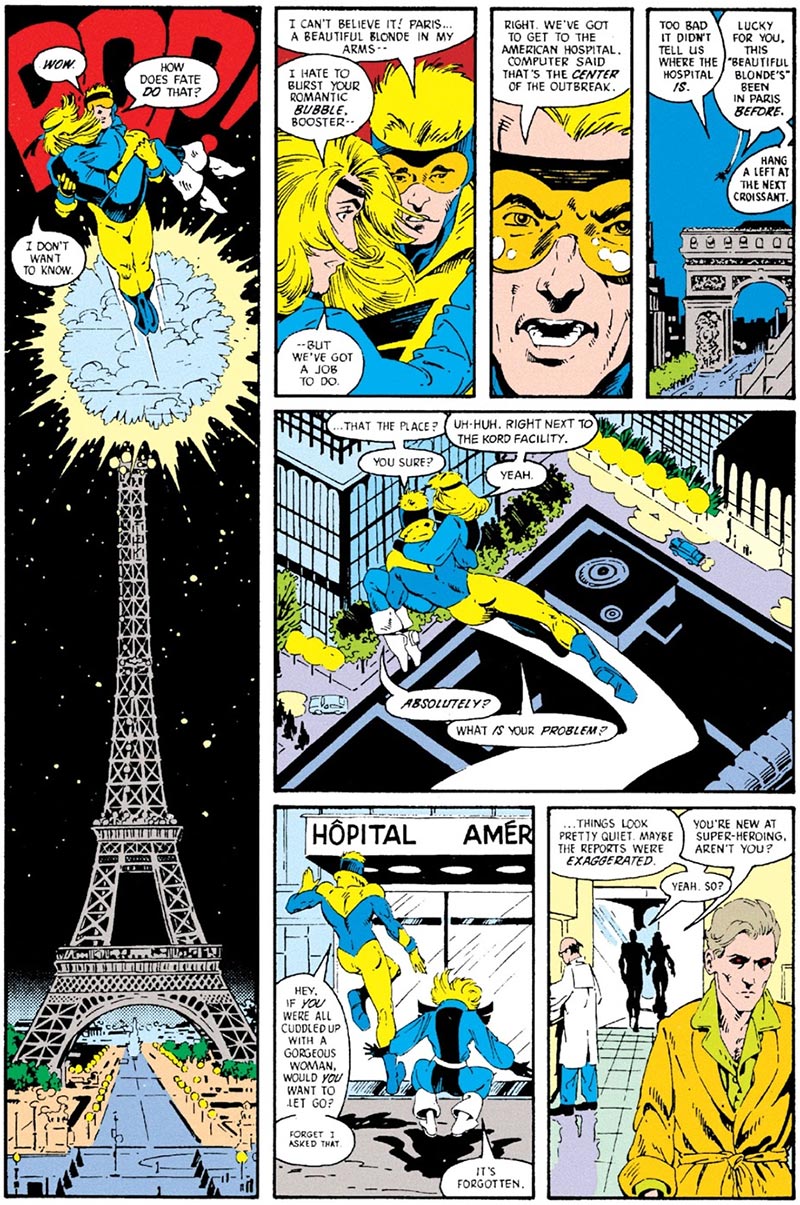
With rapport like that, it's no surprise that the "Black and Gold" team didn't outlast Canary's oft-maligned 1980s aerobics instructor-inspired costume.
As might be expected of such a new member, Booster plays a relatively minor role in the issue's resolution. And though it may come as a surprise to modern audiences, neither does Batman. The honors go to the Martian Manhunter, a true hero who will go on to teach many an up-and-comer a thing or two about the relationship between great power and great responsibility.
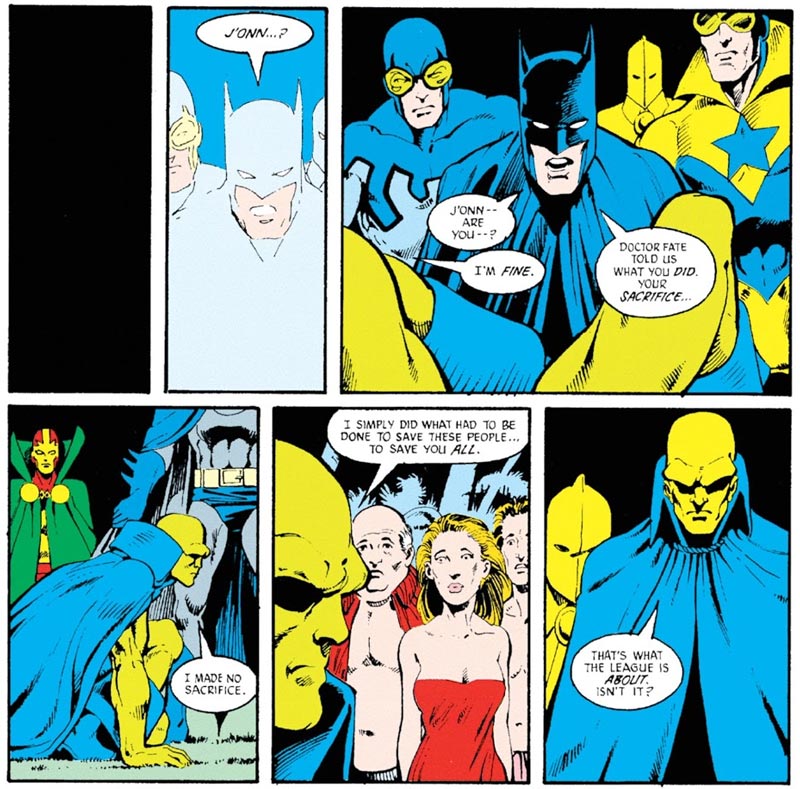
As I said, if you're looking for something to read today, you could do much worse than the first Justice League Annual.
Comments (0) | Add a Comment | Tags: annual black canary covers justice league martian manhunter
Friday, January 29, 2021
Lateral Men
It's been three weeks since Generations: Shattered was released, so you should have your copy by now, yes? Good. Because we're going to talk about it today. Specifically, we're going to talk about this panel:

art by John Romita, Jr., Danny Miki, Hi-Fi
If you've been reading DC Comics for a long of time, you may recognize most of those people, but Booster boosters in particular should probably have a pretty good idea who the Linear Men are. This is an unusual line-up of that team. It's no coincidence that many of them directly pair up with a Multiversal heroic counterpart, a contrivance that is explained in the story as the nearly omnipotent Dominus bends reality to his will.
But even accepting that, one of those Linear Men stands out. Can you spot which one?

Hint: It's this guy.
Whoever that guy is, I doubt anyone calls him "Rayak the Ravager."
Quick history lesson: The Linear Men concept was created in Adventures of Superman #476 (by Dan Jurgens) in 1991 with the introduction of The (singular) Linear Man.[1] That Linear Man died, sacrificing himself in the 30th-century to "correct" the history he'd unintentionally broken while trying to bring justice to Booster Gold. (You'll find more information on the interactions between the Linear Man and Booster Gold here.)

art by Dan Jurgens, Art Thiebert, Glenn Whitmore, Todd Klein
Shortly thereafter, in Superman #59 (by Dan Jurgens), we learn that the Linear Man was a rogue member of the mysterious Linear Men of Vanishing Point who are "dedicated to guarding the linear sanctity of the time stream." By the time of Superman #73 (by Dan Jurgens), it is well established that there are three remaining Linear Men: Matthew Ryder, Liri Lee, and Hunter.[2] (The impetuous Waverider is often an ally of the group but isn't really a member.[3])
In our group shot at the top of the post, both Liri Lee[4] and Matthew Ryder are clearly identified by name in our Generations: Shattered confrontation. Naturally, the third Linear Man should be Hunter, especially since he appears earlier in the issue beside both Liri and Ryder.
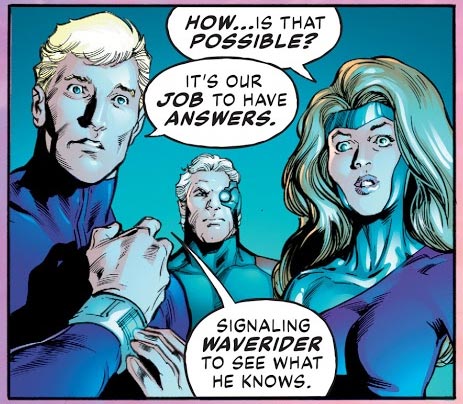
art by Fernando Pasarin, Oclair Albert, Hi-Fi
So why in the big team shot is Hunter misidentified as "Rayak the Ravager"?
If I had to take a guess, I'd say that whoever wrote the label was trying to recall the name "Ryak the Rogue" from memory. Ryak is the newest Linear Man — the first not created by Dan Jurgens. Ryak makes his first appearance in The All-New Atom #7 (by Gail Simone) in 2007, and he looks nothing like Hunter. For one thing, he's green.
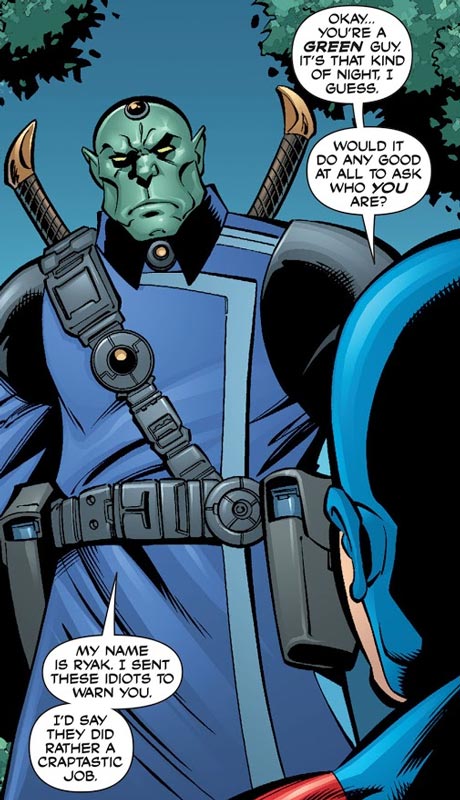
art by Mike Norton, Andy Owens, Alex Bleyaert, Pat Brosseau
As his moniker might suggest, Ryak was a solo actor in Atom, but he made a cameo appearance beside the other Linear Men on Vanishing Point in Dark Nights: Death Metal: Rise of the New God in 2020. Look closely at that panel, and alongside Ryak you'll spot Ryder, Liri, Rip Hunter, and Waverider, but Hunter is missing, replaced by none other than the original Linear Man himself![5]

art by Jesus Merino, Vincente Cifuentes, Ulises Arreola
As you can see, keeping the Linear Men straight takes as much work as the convoluted continuity they are sworn to protect. The DC Multiverse is a big place. Every once in a while, we should probably expect the writers, artists, or editors to confused a name and a face.
On the other hand, the events of both Dark Knights: Death Metal and Generations: Shattered involve realities and timelines altered by gods themselves. In which case, if Dominus wants to call Hunter "Rayak," who are we, mere mortal readers of comic books, to correct him?
1 As for the original Linear Man's real identity: it is commonly assumed to be Travis O'Connell. That name comes from the "Linear Men" entry in the Who's Who in the DC Universe Update 1993 #2 (by Roger Stern) which identifies four Linear Men by name and states that "[Travis] O'Connell eventually sacrificed his own life in the late 30th Century." Unless there were multiple Linear Mans chasing Booster Gold in the 30th century, I think we've solved that mystery. (DK apparently agrees; they identify O'Connell by name in their entry for the Linear Man in their officially-licensed The DC Comics Encyclopedia.)
2 Hunter is, as you might have guessed, Rip Hunter. But he's not the one we know. According to the story "Falling in Line" in Legends of the DC Universe 80-Page Giant #1 (by Dan Jurgens), Hunter is the evolution of the young, mischievous Rip Hunter from an alternate history that appears to closely mirror the original Rip Hunter, Time Master, whose pre-Crisis on Infinite Earths Earth-1 adventures were chronicled in a book of the same title.
3 Technically, Waverider, like Rip Hunter, is two Linear Men. See, Waverider and Matthew Ryder are the same person, separated into two timelines by the accidental death of his/their parents. In violation of the Linear Men's prime directive, Waverider himself changed the history that forced the divergence that allowed his alternate self to grow into his role as the Linear Men's Ryder. (For details, see Superman #61 by Dan Jurgens.) And while we're on the subject, I might as well mention that Matthew Ryder and Waverider first appeared in Armaggeddon 2001 #1 by Archie Goodwin... and Dan Jurgens.
4 Liri Lee is the only female member of the Linear Men. I probably don't need to tell you, but she was created by Dan Jurgens for Superman #59. She takes the name Linear Woman in Time Masters: Vanishing Point #6 (by... oh, you know). That may take place in a different reality or at a different point in Liri Lee's future chronology than the events of Generations: Shattered. The biggest problem with hanging out at Vanishing Point is that time and space don't have meaning anymore.
5 This isn't the first time O'Connell has been seen since his "death" in Adventures of Superman #478 (by Dan Jurgens), and there are many well-intentioned websites that appear to confuse O'Connell and Hunter, which is understandable. (Heck, I did it myself when I first listed my annotations for the issue, and I obviously know better.) Both O'Connell and Hunter share a 1990s affinity for shoulder pads, pointless belts, and cybernetic parts. And, of course, they are both Dan Jurgens creations. Rule of thumb: if he has black hair and a holster, it's O'Connell; white hair, Hunter.
Comments (2) | Add a Comment | Tags: characters dan jurgens fernando passin gail simone generations hunter jesus merino john romita jr linear man linear men liri lee mike norman rayak the ravager rip hunter ryak the scout waverider
Friday, October 16, 2020
The Best of Booster Gold: Booster Gold v2 No5
In Booster Gold Volume 2, our hero became a time travelling policeman, someone whose job was to travel through time and ensure that history unfolds correctly. Given that the DC Universe has a propensity for frequent, reality-shifting Crises, the obvious question becomes "what is correct"? What history can be changed, and what can't?
Booster Gold #5 answers that question, which is why it is in my list of the twelve best Booster Gold comics.

To teach Booster Gold (and his audience) about the limits of interfering with history, the original Time Master, Rip Hunter, sends Booster back to one of the most known and respected stories in DC Comics history: The Killing Joke. Booster soon learns there is nothing funny about it.
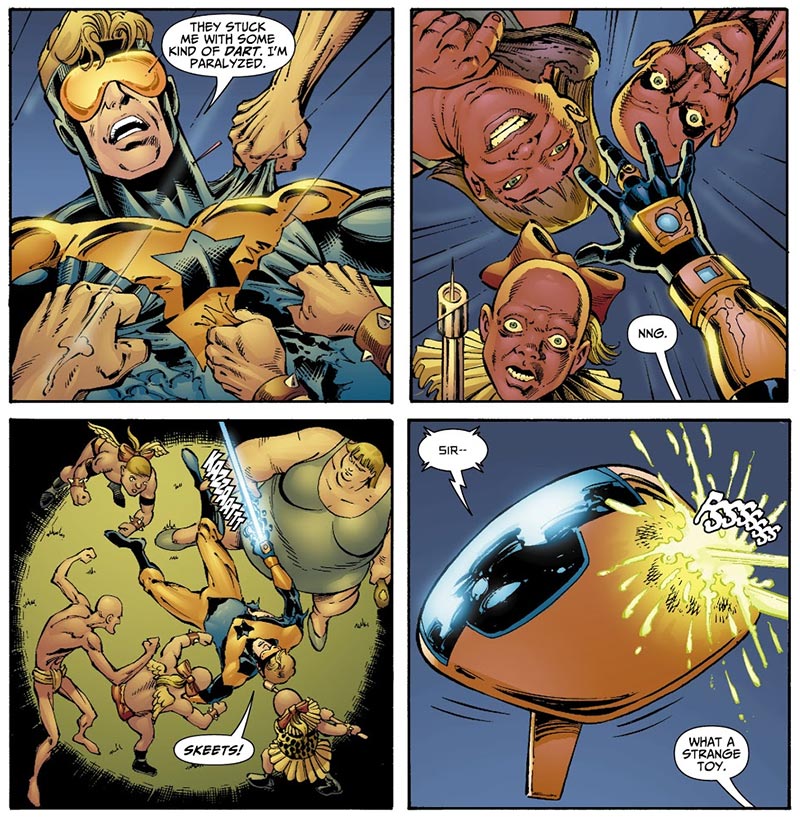
What follows are about a dozen pages of Booster Gold (and Skeets!) having his shiny butt handed to him by the Joker and his goons. Over and over again, Booster tries to prevent the Joker from brutalizing Barbara Gordon. Over and over again he fails.
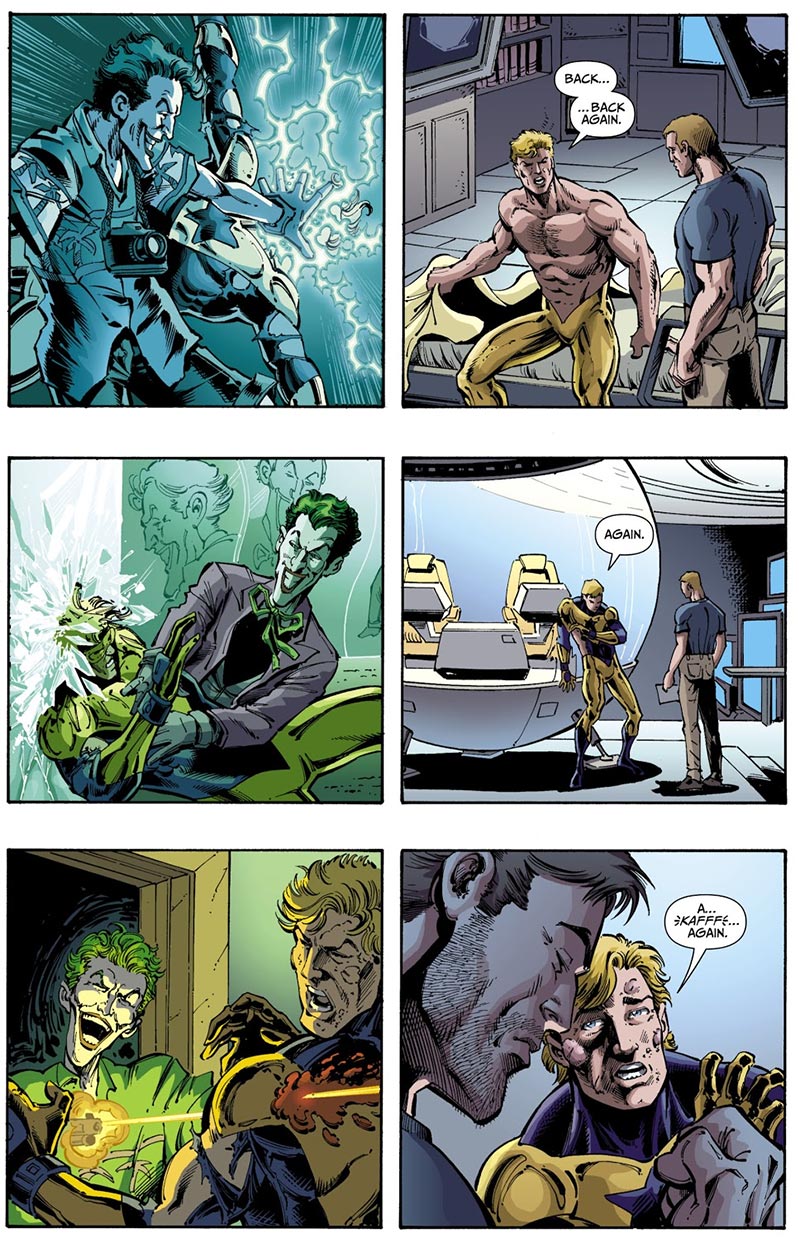
It's not always an easy read, but it is a worthwhile one — especially when you realize the gambit Hunter is playing and at what personal cost. It is also a valiant definition of true heroism courtesy of writer Geoff Johns. No matter how many times Booster Gold gets knocked down, he always gets back up again. What a guy!
It should be noted that a large part of what makes this light-on-dialogue book such a great read is the art, which Dan Jurgens and Norm Rapmund intentionally based on the original material drawn by Brian Bolland.
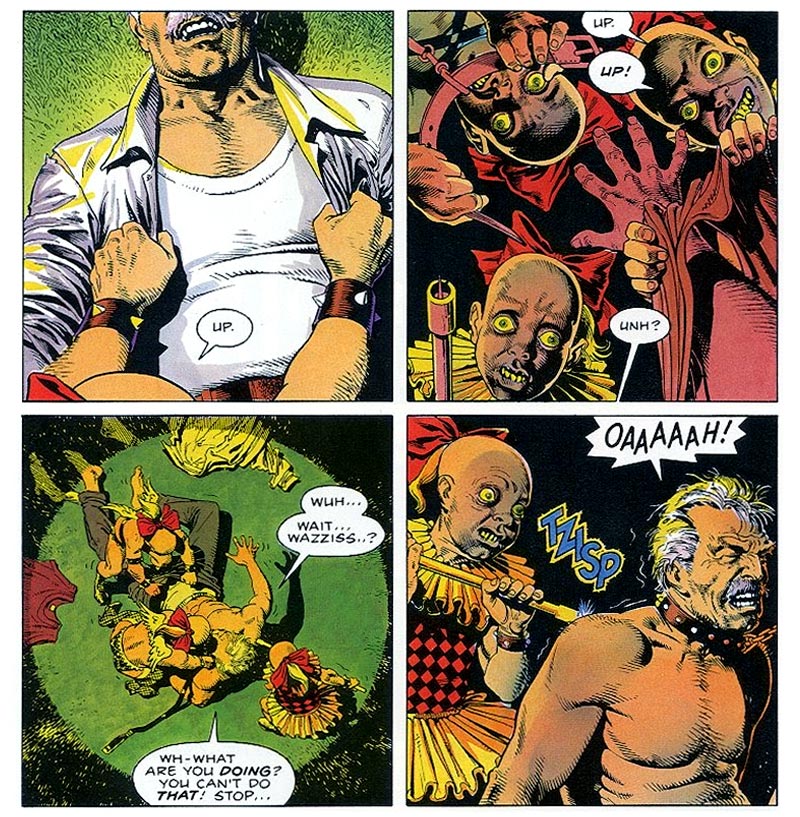
While legendary writer Alan Moore always gets most of the credit, Bolland's detailed and disturbing art is no small part of what has made The Killing Joke an enduring classic, and he deserves some recognition for making Booster Gold #5 one of The Best Booster Gold Stories Ever.
Comments (2) | Add a Comment | Tags: batman best of brian bolland dan jurgens geoff johns joker norm rapmund rip hunter skeets the killing joke
SITE SEARCH
SPOILER WARNING: The content at Boosterrific.com may contain story spoilers for DC Comics publications.
Booster Gold, Skeets, and all related titles, characters, images, slogans, logos are trademark ™ and copyright © DC Comics unless otherwise noted and are used without expressed permission. This site is a reference to published information and is intended as a tribute to the artists and storytellers employed by DC Comics, both past and present. (We love you, DC.) Contents of this page and all text herein not reserved as intellectual property of DC Comics is copyright © 2007-2024 BOOSTERRIFIC.com. This page, analysis, commentary, and accompanying statistical data is designed for the private use of individuals and may not be duplicated or reproduced for profit without consent.
